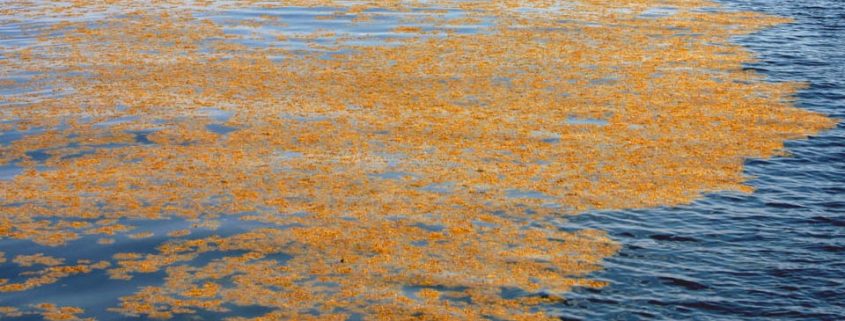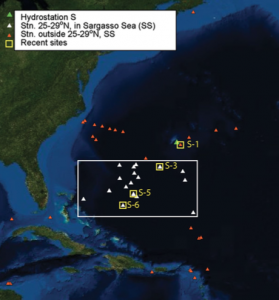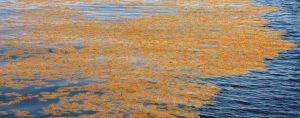Effects of temperature and CO2 increases on Sargassum Seaweed Communities
by Alice Schreiber, RJD intern
Located within the North Atlantic Gyre is a floating ecosystem of brown algae called Sargassum. The seaweed forms clumps the size of fists, or larger raft-like clusters that group together forming a biodiverse habitat, extending up to 100 miles or more, in a place that is otherwise oligotrophic, or lacking in life sustaining nutrients. This mass of algae has come to be known as The Sargasso Sea.
The Sargasso Sea has been designated as “essential fish habitat” and provides a high-productivity location for pelagic fishes and seabirds to feed and spawn. Pelagic Sargassum is a habitat to a reported 100 fish species, four turtle species, and over 145 invertebrates, sponges, fungi, bacteria, diatoms, and protists (Coston-Clements et al. 1991; Trott et al. 2010; Thiel and Gutow 2005a).
Ocean acidification and rising water temperatures caused by an increase of atmospheric carbon dioxide may impact Sargassum and the species that rely on it. Higher levels of CO2 can stimulate the growth of macroalgae but can reduce the formation rate of calcareous skeletal structures, decreased reproduction, and increase mortality in organisms with shells or calcareous exoskeletons
Huffard et al., published a paper this year hypothesizing that seaweed will survive changing ocean conditions better compared to the faunal organisms in the same community. The data gathered in this study is compared to 88 historical datasets and data taken from 1966 to 1975 from the same location between Bermuda and the Bahamas. Biodiversity, sea surface temperatures and the CO2 concentration was studied.
The researchers found that sea surface temperatures at one of the stations near Bermuda has increased slightly and gradually since 1969 (Huffard 2014). In the same location pCO2 has increased since 1984. Mobile macrofauna samples for diversity and evenness were significantly lower in this study compared to ones conducted in 1972 and 1973. A key isotherm in the Sargasso sea has shifted northward and extreme weather events have higher wind speed and wave height. Differences in sampling methods between this study and the historic studies do not allow for statistical comparison, but calcifying bryozoan coverage was low compared to samples taken in the 1970s.
These findings support the hypothesis that different species and animal communities vary in their ability to withstand temperature and pH changes. It is possible that increased acidity due to a lower pH leads to a decrease in bryozoan coverage by negatively impacting their ability to form exoskeletons. Long-term monitoring of Sargassum communities is necessary to determine whether these changes are indicative of a failing ecosystem or just low points of diversity in a naturally varying ecosystem.
Coston-Clements L, Settle LR, Hoss DE, Cross FA (1991) Utilization of the Sargassum habitat by marine invertebrates and vertebrates: a review. NOAA Technical Memorandum NMFS-SEFSC-296
Trott TM, McKenna SA, Pitt JM, Hemphill A, Ming FW, Rouja P, Gjerde KM, Causey B, Earle SA (2010) Efforts to enhance protection of the Sargasso Sea. Proceedings of the 63rd Gulf and Caribbean Fisheries Institute. Nov 1–5, 2010, San Juan, Puerto Rico, pp 282–286
Thiel M, Gutow L (2005a) The ecology of rafting in the marine environment. I. The floating substrata. Oceanographic Marine Biology Annual Revue 42:181–264
Huffard, C. L., von Thun, S., Sherman, A. D., Sealey, K., & Smith Jr, K. L. (2014). Pelagic Sargassum community change over a 40-year period: temporal and spatial variability. Marine biology, 161(12), 2735-2751.






Leave a Reply
Want to join the discussion?Feel free to contribute!